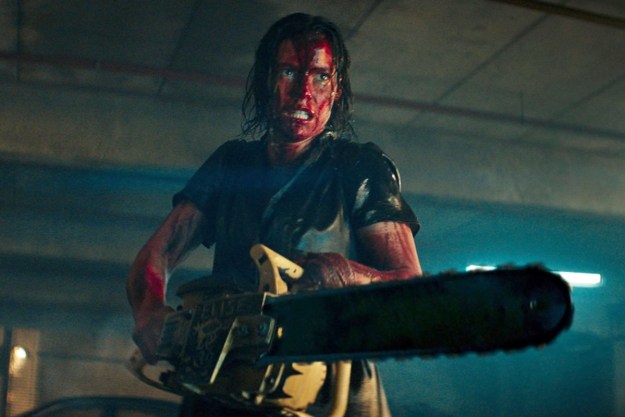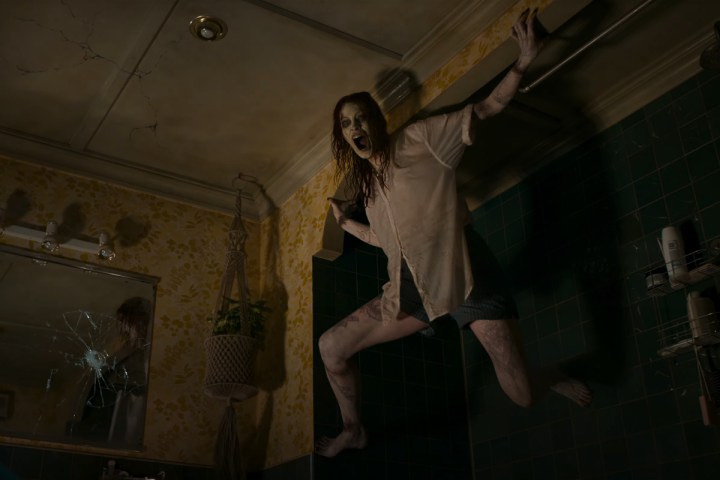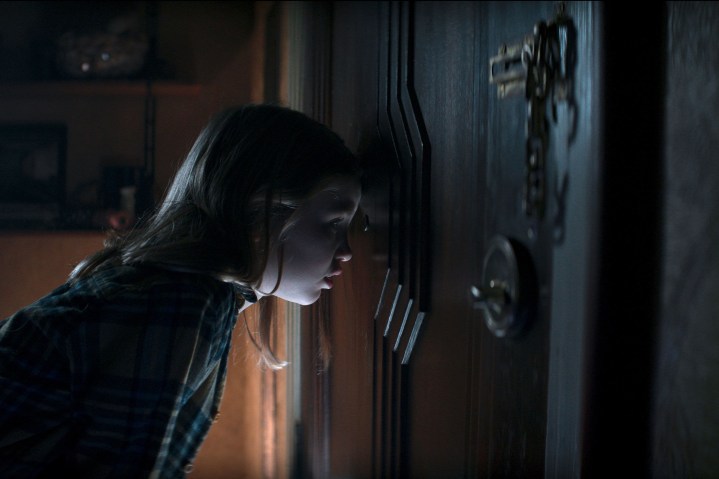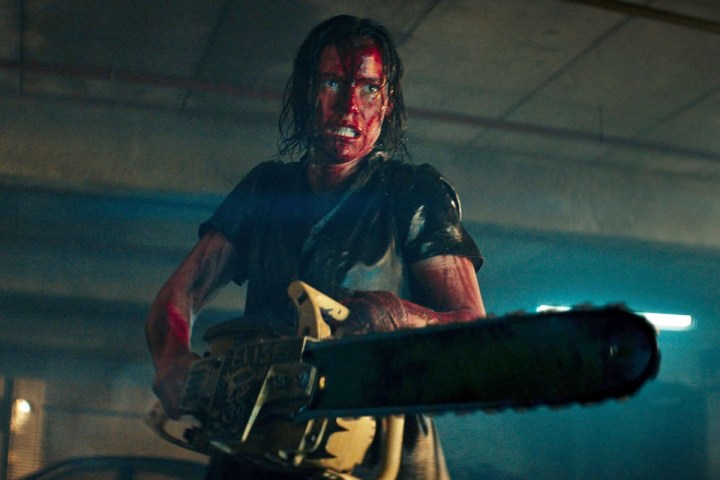
“Despite its flaws, Evil Dead Rise is a perfectly fine and suitably fun, if not necessarily extraordinary, addition to one of the horror genre's most eccentric and enduring franchises.”
- Alyssa Sutherland's transformative lead performance
- An unforgettable, terrifying prologue
- An effective, darkly comic horror tone throughout
- Numerous logic-breaking character decisions
- A plot that feels a bit too familiar
- Inconsistent cinematography throughout
Evil Dead Rise understands the assignment.
The new film is the first feature installment in the undying Evil Dead franchise since director Fede Álvarez’s divisive 2013 reboot hit theaters 10 years ago. Evil Dead Rise doesn’t present itself as a sequel to Álvarez’s reboot, though. The film, instead, operates like an anthology episode in a long-running series, which is to say that it makes little to no allusions to the events of the previous Evil Dead movies, including those that were made by Sam Raimi in the 1980s and ’90s. At times, that narrative disconnection from what’s come before it does leave Evil Dead Rise feeling a little weightless.
Fortunately, writer-director Lee Cronin knows how to make the film feel like a natural addition to the beloved horror franchise without having to rely on too many literal connections. The film is overflowing with all the blood, gore, and general nastiness that fans have come to expect from the Evil Dead franchise. Across the movie’s thankfully succinct 96-minute runtime, Cronin is able to horrify you, gross you out, and make you laugh at even the darkest of moments. The filmmaker’s only real crime is that he has made an Evil Dead movie that is perfectly fine and suitably fun, if not necessarily extraordinary.

The film begins, like most Evil Dead sequels logically should, by speeding between the trees of the kind of forest that could be found practically anywhere in America. Within Evil Dead Rise’s first few minutes, though, Cronin not only manages to pay homage to the most famous shot from Raimi’s 1981 horror classic, but he’s also able to follow his tribute up with a joke that feels far too meta to work as well as it does. Mere minutes later, Cronin once again honors Raimi’s enduring legacy by using Emily Brontë’s Wuthering Heights to both poke fun at one all-too-common film trope and create one of the most genuinely chilling beats in the Evil Dead franchise’s history.
These moments all unfold during an opening prologue that, for the most part, bears little to no narrative connection to the rest of the film’s story, though it does effectively key first-time Evil Dead viewers into exactly the kind of brutal, darkly funny ride that lies in store for them. The film then spends the bulk of its runtime with Beth (Lily Sullivan), a guitar technician who finds out that she’s pregnant and decides to travel to Los Angeles to pay an unannounced visit to her sister, Ellie (Alyssa Sutherland), and her nieces and nephew, Kassie (Nell Fisher), Bridget (Gabrielle Echols), and Danny (Morgan Davies).
Beth’s desire to receive some life advice from her sister is quickly thrown out the window, though, when Danny discovers not only the Book of the Dead hidden in a bank vault underneath his family’s apartment building, but also a series of vinyl recordings that unleash the malevolent spirits contained within its pages. These spirits ambush and possess Sutherland’s Ellie — transforming her from a loving mother into a murderous entity hell-bent on killing every person located inside the film’s central, condemned apartment building, including the members of her own family.

With Sutherland’s possessed Ellie either finding new ways to break into her family’s apartment or always standing guard outside its door, Evil Dead Rise spends most of its runtime within the confines of one apartment. That aspect of it not only makes the film feel like the Evil Dead franchise’s smallest installment to date, but also its most suffocating. The movie’s characters have almost nowhere to go, and Cronin uses their constantly close proximity to danger to keep the film’s tension at a nearly unbearable level for almost the entirety of its second half.
In the moments when Ellie and the film’s other characters do come face-to-face, Cronin wholeheartedly embraces a kind of over-the-top horror violence that fluctuates between cartoonish and bloodcurdlingly terrifying. One moment involving the unfortunate removal of another character’s eyeball feels like it could have come out of a Looney Tunes cartoon, while another involving a cheese grater finds the perfect balance between tongue-in-cheek humor and sheer, visceral horror. The film doesn’t feature quite as many standout set pieces as some of its Evil Dead predecessors, but it still delivers more than a few moments that are genuinely memorable — if only for just how shockingly brutal they are.
Evil Dead Rise’s limited scope does present Cronin with a few noteworthy challenges. The filmmaker frequently has his characters split up into different rooms, even when it defies all logic for them to do so, solely so that he can have the time and space to set up new threats. One character’s prolonged stay in a kitchen particularly pushes Evil Dead Rise’s admittedly loose sense of logic close to its breaking point. While Cronin and cinematographer Dave Garbett often find unexpected new ways to visually express the film’s nightmarish reality, there are stretches of Evil Dead Rise that look muddy and underlit, which makes it difficult to constantly remain lost in its world.

Ultimately, despite its refreshingly urban setting, Evil Dead Rise doesn’t take its franchise to any places that feel all that new. The film’s story sticks to many of the same beats as those that have come before it and, along the way, Cronin effectively makes you feel the same pervasive sense of hopelessness as Beth and the children she’s suddenly been tasked with protecting. As viscerally effective and intense as Evil Dead Rise gets, though, anyone remotely familiar with the franchise’s previous installments will be able to predict where it’s going for most of its runtime.
The familiar nature of its story and structure prevents Evil Dead Rise from — forgive the pun — rising too far above its contemporary horror competitors. For longtime Evil Dead fans, that won’t necessarily be an issue. The film is, in many ways, exactly what the Evil Dead franchise needed: a competent and energetic reentry into its world that doesn’t so much reinvent the series’ formula as it does remind viewers of the pleasures that it has been able to deliver all along. In that regard, Evil Dead Rise is a bit of a minor accomplishment — one that’s just as delightfully mean-spirited and unrepentantly brutal as fans will want.
It’s not like there aren’t a few truly remarkable aspects of Evil Dead Rise, either. Alyssa Sutherland’s performance as Ellie is so physically impressive that she makes you feel every unnatural movement her possessed character makes and taste the poison in every intentionally awful thing she says. Cronin, for his part, also expands the film’s influences beyond just the confines of the Evil Dead franchise. There are, in particular, several nods to Stanley Kubrick’s The Shining, including one homage that is so blatant it has no right to be as effective as it is.
One could arguably say the same thing about Evil Dead Rise, a film that comfortably goes through many of the same motions as its predecessors ,but still manages to get its hooks in you. The film, consequently, proves once again that some formulas truly are harder to kill than others.
Evil Dead Rise is now playing in theaters. If you want to know all the spoilers about the movie, read Evil Dead Rise’s ending, explained.



